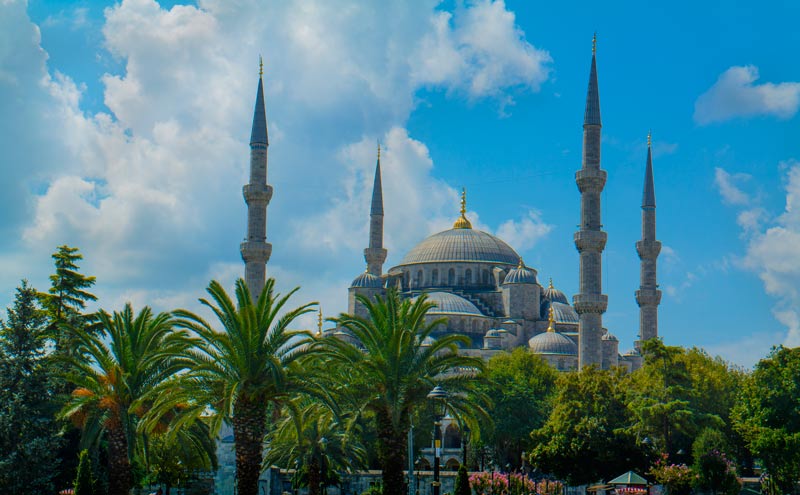If a question is asked, which is the best mosque built by the Turks, the first of the mosques that will come to mind will undoubtedly be the “Sultanahmet Mosque“. The mosque, which gave its name to the area where it is located, looks so magnificent that it almost attracts people to itself and you can feel its peaceful 400-year-old atmosphere when you enter.. When you visit the mosque, which is one of the most beautiful works of our ancestors, you are proud that even the tourists watch the mosque with great admiration.. So, “who built the Sultanahmet Mosque? Let us give you information about this magnificent mosque by answering frequently asked questions such as “Who is the architect of the Blue Mosque?“..
- History
- Features
- Blue Mosque
- Architect
<
Information About Sultanahmet Mosque
17. This unique mosque, which was built at the beginning of the century, left a great impression on those who visited it not only when it was built, but also in every century after it.. Known as one of the greatest structures of the period it was built, the mosque was visible even from the Bosphorus and became one of the symbols of Istanbul.. It is one of the structures that should be seen by those who will visit the historical peninsula.. In fact, according to us, “Sultanahmet Mosque” alone is sufficient reason to go to the historical peninsula.
1. Its History (Construction of Sultanahmet Mosque)
Sultan I.Ahmet ascended to the throne of the Ottoman Empire in 1603. However, there is really interesting information here because Sultan Ahmet I 14. age 14. He ascends the throne as the Ottoman sultan and dies after only 14 years on the throne.. The presence of magnificent mosques in many parts of the city with the names of his ancestors urges Sultan Ahmet to the idea of building a more magnificent mosque than others.
The mosque is built right next to Istanbul’s famous historical hippodrome.. However, Ayşe Sultan Palace is located at the point where the mosque is planned to be built.. The palace is bought by the Sultan for 30 thousand gold and the necessary construction works are started.. In addition, the fact that it was built directly opposite Hagia Sophia, which is the favorite of Byzantine works, reveals the comparative point of the Ottoman architecture.. In 1609, the first step of the construction was taken when Sultan Ahmet struck the first digging for the foundation excavation.. The pickaxe used by the sultan during the foundation excavation of the mosque is exhibited in Topkapı Palace today.. Foundation digging takes more than 30 days with nearly a thousand workers. The construction of the mosque takes exactly 7 years, 5 months and 6 days and it is opened to worship in 1616.
2. Features of the Mosque
The prayer area, which was built on a rectangular plan together with the mosque courtyard and in a square plan, consists of 2.646 m2 in total. The diameter of the dome, which is 43 meters high, is 23 meters.. The dome, which draws attention with its size, is located on four large columns.
The ground has been raised so that the mosque can be seen from many points.. The courtyard where the fountain is located in front of the mosque was built on 26 columns in total.. There are 30 domes in total in this courtyard.. You can enter this courtyard through three different doors with stairs.. Another feature of these doors is the presence of precious bronze doors on them.
The number of interior windows of such a large mosque will also be high.. The magnificent images created by the colorful windows decorated with tiles increase the interior ambiance of the mosque.
3. The Mosque with Six Minarets
There are 6 minarets in total in the mosque, which is unusual.. Four of these minarets are at the four corners of the mosque, while the other two are on either side of the courtyard.. Contrary to mosques that usually consist of 4 minarets, there was some backlash when 6 minarets were built.. Because there are 6 minarets in the Masjid Haram in the Kaaba.. These reactions are reduced by the Sultan’s construction of the seventh minaret to the Masjid Haram.
4. Where Does the Name Blue Mosque Come From? Why Blue Mosque?
Sultanahmet Mosque is named as Blue Mosque by Europeans. For this reason, the mosque has become famous abroad as the Blue Mosque today.. The interior of the mosque -especially the inside of the dome- is decorated with approximately 21 thousand tiles.. Because these tiles are mostly blue in color, they were called the Blue Mosque by foreigners.
5. Architect Sedefkar Mehmet Ağa
One of the most curious things is who the architect is.. The architect of the mosque is Mimar Sinan‘s student, Sedefkar Mehmet Ağa. Considered one of the most important architects of Ottoman architecture, Sedefkar Mehmet Ağa, died one year after the construction of the mosque was completed.
Also, “Sultanahmet Mosque”…

